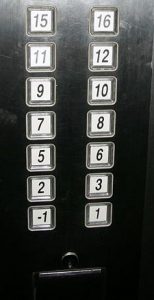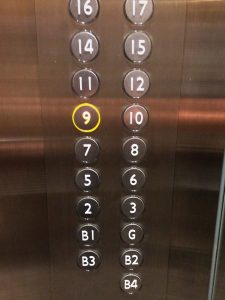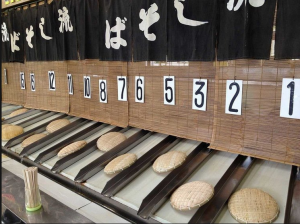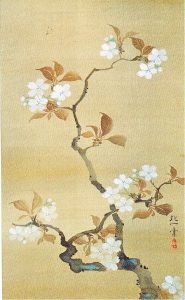All ancient cultures were based, in addition to religions, on a set of magical-religious practices, beliefs and superstitions which, even if they appear irrational and unscientific to our Cartesian eyes today, guided and permeated all aspects of daily life.
In Japan, as early as the Heian period (794-1185), such beliefs and superstitions were well established, as they were either part of the indigenous Shintoism or had been imported with Buddhism, Confucianism and Taoism.
For example (see article 50th ) in Japanese language, the avoidance of using
 shi the number four
shi the number four
comes from a superstition since the kanji for the number 4 in the on (educated, Chinese) reading is read shi and one of its fifty or more homophone kanji
 is shi, meaning death
is shi, meaning death
so the sound shi means both 4 and death and for this reason it was avoided. To say the number 4, the reading kun (popular Japanese reading) is preferred, which sounds like yon.


Here you can see some lift panels where the number 4 does not appear

A photo of a market stall where the 4 is missing but also the number 9 kyū, too similar to the sound ku = suffering, pain.
The “Office of Omens”, created at the Imperial Court in 675 A.D., dealt with the study of good and bad omens in order to help both individuals and the government in its politics: the decisions “that made history” were also taken on the basis of what the Masters of Yin-Yang said.
It is interesting to know that there were temporary directional taboos so that, for example, on certain ‘unfavourable days’ an army could not march in the direction believed to be unlucky: so either it stopped, even for up to a month until these expired, or it took an alternative route to the unlucky direction which was certainly longer and wasted precious time.
Some examples from ” The World of the Shining Prince: Court Life in Ancient Japan” by Ivan Morris:
The emperor or dignitaries would cancel a journey if the direction that day was inauspicious.
Certain activities were forbidden according to criteria such as the age and/or the sex of those involved: for example, at the age of 16 one was required to avoid travelling in the inauspicious direction of north-west.
Other taboos were linked to the personal cycle of 60 days – based on the combination of the 12 animals of the zodiac (mouse, buffalo, tiger, hare, dragon, snake, horse, goat, monkey, cock, dog, pig) plus the five elements (water, wood, fire, metal, earth). Therefore some activities were, on a given day or at a given time, unlucky and therefore “forbidden”, such as cutting one’s hair, clipping one’s fingernails, taking a bath, starting a love affair, starting a medical treatment, going on a journey.
One day out of every 60 – The Monkey Day – no sleep was allowed because of the danger of evil powers attacking during the night.
At regular intervals the imperial guards on duty at Court made the strings of their bows vibrate to ward off evil spirits and the whole day at Court was set, we would say “limited”, by these beliefs, superstitions for us.
The Masters of Yin-Yang were held in the highest esteem maintained until the Edo period and demonstrated by the fact that they were allowed to use sedan chairs for travel, a means reserved only for the imperial and Shogunal aristocracy or high-ranking priests. Until the end of the Edo period, their divinations were requested by members of the Imperial and Shogunal court as well as by the emerging class of wealthy merchants and craftsmen.
Besides astrological calculations, the study of favourable and unfavourable auspices, directional taboos and the interpretation of dreams, the Yin-Yang Masters also dealt with: Feng shui (water-wind).
Feng-shui has also influenced ikebana, as we shall see in Article 9.



